Understanding Autism and Emerging Therapies
Autism Spectrum Disorder (ASD) is a complex neurodevelopmental condition characterized by challenges in social interaction, communication, and repetitive behaviors. As conventional interventions such as Applied Behavior Analysis (ABA) continue to form the cornerstone of autism therapy, emerging treatments like cannabis-derived products are gaining attention. This article explores how marijuana and its components, particularly cannabidiol (CBD), may contribute to alleviating symptoms of autism, alongside insights on traditional behavioral therapies and future research directions.
What is Applied Behavior Analysis (ABA) Therapy?

Definition and principles of ABA
Applied Behavior Analysis (ABA) therapy is a scientific, evidence-based approach focused on understanding and improving specific behaviors. It is widely used to support individuals with autism spectrum disorder (ASD) by promoting positive behaviors such as communication, social interaction, and daily living skills, while reducing behaviors that may be harmful or challenging.
Behavior modification techniques
ABA employs behavior modification techniques like positive reinforcement, where desired behaviors are rewarded to encourage repetition. Other methods include prompting to guide correct responses and functional communication training to replace challenging behaviors with more appropriate communication.
Individualized treatment plans
ABA programs are highly individualized. After a comprehensive assessment of the individual's needs, personalized goals are set. Progress is tracked meticulously through continuous data collection, ensuring that interventions are effective and can be adjusted as needed.
Common ABA methodologies
Several ABA methodologies cater to different learning styles and developmental levels. These include Discrete Trial Training (structured teaching broken into small steps), Pivotal Response Treatment (focus on pivotal areas like motivation), and the Early Start Denver Model (integrates ABA principles in play-based interactions).
Therapeutic goals for autism spectrum disorder
The overarching goals of ABA therapy for individuals with ASD are to enhance cognitive and language skills, improve social interactions, encourage independence in daily activities, and reduce behaviors that interfere with learning and social engagement. Intensive ABA therapy has been shown to lead to meaningful improvements across these domains.
Professionals Providing ABA Therapy and Their Qualifications

Types of ABA professionals
ABA therapy is delivered by a range of trained professionals, primarily including Board Certified Behavior Analysts (BCBAs) and registered Behavior Technicians (RBTs). BCBAs are master’s-level practitioners who specialize in applied behavior analysis. RBTs, on the other hand, are paraprofessionals trained to implement ABA interventions under supervision.
Certification and educational requirements
BCBAs must hold at least a graduate degree in behavior analysis or a related field and obtain certification from the Behavior Analyst Certification Board (BACB). This certification requires passing a rigorous exam and completing supervised practical experience. RBTs need to complete a formal training course, pass a competency assessment, and maintain certification by adhering to ongoing supervision and ethical guidelines.
Roles and responsibilities in therapy delivery
BCBAs design individualized treatment plans based on thorough assessments of the client’s behavior, considering antecedents and consequences to develop effective interventions. They oversee therapy progress, modify strategies as needed, and provide guidance to RBTs. RBTs directly implement the treatment plans, deliver one-on-one services, collect data on behaviors, and report progress to their supervising BCBAs. Both collaborate to use evidence-based techniques like positive reinforcement to support skill development in individuals with autism spectrum disorder and other developmental disabilities.
Customization and Structure of ABA Therapy for Autism

How is ABA therapy typically structured and customized for each individual receiving treatment?
ABA (Applied Behavior Analysis) therapy is a highly individualized approach that begins with an initial comprehensive assessment. This assessment involves direct observation and evaluation to identify the child's current abilities, challenges, and learning style.
Following this, therapists collaborate with the child’s caregivers to set specific, measurable goals tailored to the child's unique needs. These goals often address social skills, communication, behavior management, and daily living skills.
Therapy sessions are structured around engaging, hands-on activities such as play, social interaction exercises, language practice, and behavior modification techniques. Positive reinforcement methods, like verbal praise, token economies, or access to preferred items, are used consistently to encourage skill acquisition and reduce challenging behaviors.
Data collection is integral throughout therapy sessions. Therapists track behaviors, skill milestones, and progress towards goals, using this information to continually inform treatment decisions.
Regular communication and collaboration with parents and caregivers ensure therapy aligns with home routines and family priorities. This partnership fosters generalization of skills outside the therapy setting.
Finally, treatment plans are dynamic and adjusted based on collected data and evolving child needs. Emerging evidence and technological advancements also influence plan modifications to improve therapeutic outcomes.
Limitations of Current Autism Treatments and the Search for Alternatives
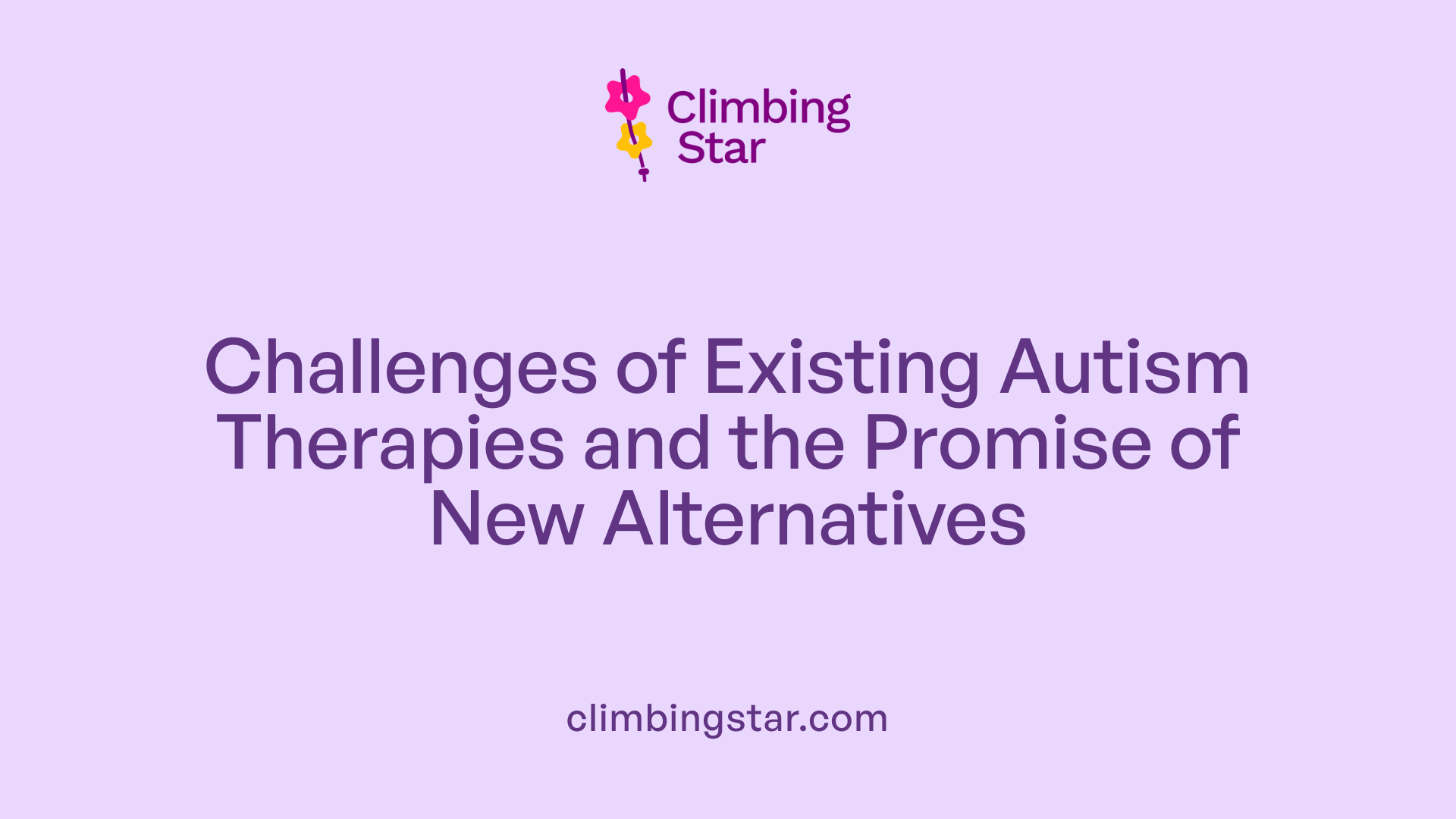
What are the core symptoms of ASD and treatment challenges?
Autism spectrum disorder (ASD) primarily involves difficulties with social interaction, communication, and the presence of restricted repetitive behaviors. Despite these defining features, there is currently no effective treatment that directly addresses the core symptoms of ASD. This lack of targeted therapies creates significant challenges in managing the disorder.
What are the limitations of existing behavioral therapies?
Behavioral interventions remain the mainstay of treatment for ASD, focusing on improving social skills, communication, and adaptive behaviors. However, these therapies often require intensive and long-term commitment, and the degree of improvement varies widely among individuals. Moreover, these interventions do not fully alleviate associated behavioral problems such as aggression, irritability, and anxiety.
What is the rationale for exploring new treatment avenues?
Due to the insufficient efficacy of existing treatments on core and associated symptoms, there is growing interest in alternative therapies. Cannabis and cannabidiol (CBD), which influence neurotransmitter systems and the endocannabinoid system, present promising avenues. Preliminary research suggests they could improve behavioral symptoms, cognitive functions, and quality of life in individuals with ASD, warranting further investigation.
How do comorbidities complicate ASD management?
Many individuals with ASD also experience comorbid conditions such as anxiety, epilepsy, and sleep disturbances. These additional complications can exacerbate the overall disability and complicate treatment strategies. The presence of comorbidities often leads to polypharmacy, increasing the risk of side effects. This complexity underscores the need for treatments that can address both ASD symptoms and associated conditions in an integrated manner.
Cannabis and Cannabinoids: An Emerging Therapeutic Option for Autism

What are the main components of cannabis used for ASD treatment?
Cannabis products utilized for autism spectrum disorder (ASD) treatment typically contain cannabidiol (CBD) and tetrahydrocannabinol (THC). CBD-enriched formulations are most common, with products often containing high levels of CBD (ranging from 20:1 to 30:1 CBD to THC ratios) and small amounts of THC. For example, some treatments use cannabis oils with about 30% CBD and 1.5% THC, administered orally multiple times per day.
What does preliminary clinical and preclinical research say?
Emerging evidence from preclinical studies and initial clinical trials suggests that cannabis and cannabinoids may relieve a variety of ASD symptoms. Low endocannabinoid levels, such as anandamide deficits found in autistic children, hint at a therapeutic target involving the endocannabinoid system. Cannabidiol can inhibit FAAH, an enzyme that breaks down anandamide, potentially enhancing endocannabinoid signaling.
Imaging studies in adults with ASD reveal that CBD modulates brain connectivity and neurotransmitter balance—particularly the glutamate and GABA systems—both crucial to neurobiological regulation in ASD. Early clinical data from prospective and open-label studies show improvements in behavioral symptoms, cognition, social interaction, and quality of life, with mostly mild and transient side effects like restlessness or changes in sleep patterns.
Which symptoms does cannabis treatment aim to improve?
Cannabis therapy has been reported to impact multiple symptom domains associated with ASD:
- Core symptoms: Improvements in social communication and interaction.
- Behavioral problems: Reduction in hyperactivity, aggression, irritability, rage attacks, and self-injury.
- Comorbid conditions: Alleviation of anxiety, sleep disturbances, epilepsy, and ADHD-like symptoms.
- Cognitive functions: Enhancements in attention, sensory sensitivity, language, and repetitive behaviors.
Patients and families also report improved mood, daily activities, and overall quality of life after cannabis treatment.
How variable are cannabis formulations and dosing?
Formulations and dosages are notably diverse across studies. CBD doses used in oral solutions range roughly from 600 mg upwards, with THC analog doses generally low to minimize psychoactive effects. Individualized dosing is common, with average CBD doses reported around 2.87 mg/kg but spanning a wide range (0.42 to 6.67 mg/kg) depending on patient needs and clinical judgments.
The variability reflects ongoing attempts to identify optimal treatment protocols, as standardized dosing models remain to be established. Despite these differences, the safety profile appears favorable, with most patients tolerating treatment well.
| Aspect | Details | Notes |
|---|---|---|
| Cannabis Components | Predominantly CBD-rich oils with small THC content | Ratios often 20:1 to 30:1 CBD:THC |
| Mechanism of Action | Modulation of endocannabinoid system; inhibition of FAAH enzyme; neurotransmitter regulation (glutamate, GABA) | Effects on social behavior pathways like oxytocin release |
| Symptom Domains Targeted | Social interaction, cognition, behavioral problems, anxiety, sleep, epilepsy | Includes core and noncore ASD symptoms |
| Dosing Variability | Wide range; individualized dosing common | Doses from ~0.42 to 6.67 mg/kg CBD reported |
| Safety Profile | Generally good; mild, transient side effects like restlessness and sleep changes | Rare serious adverse events reported |
Potential Mechanisms Underlying Cannabis Effects in ASD

Role of the Endocannabinoid System
The endocannabinoid system plays a crucial role in regulating various physiological processes, including those in the nervous system. Research has identified low levels of endocannabinoids, such as anandamide, in children with ASD. This deficiency suggests the system might be a therapeutic target for alleviating symptoms associated with autism spectrum disorder.
Modulation of Neurotransmitter Systems (Glutamate and GABA)
Cannabinoids like cannabidiol (CBD) have been shown to affect key neurotransmitter systems involved in excitation and inhibition within the brain. Imaging studies in adults with ASD indicate that CBD influences brain connectivity by modulating glutamate and gamma-aminobutyric acid (GABA) levels. These neurotransmitters are critical for maintaining the balance of neural activity often disrupted in ASD.
Enzymatic Pathways Involving Anandamide and FAAH
CBD may inhibit the enzyme fatty acid amide hydrolase (FAAH), which normally breaks down anandamide. By blocking FAAH, CBD potentially increases anandamide levels, enhancing its beneficial effects on the endocannabinoid system. This pathway could underlie some of the symptom improvements observed in ASD patients treated with CBD-rich cannabis products.
Influence on Neurobiological Dysregulation in ASD
Cannabis treatment appears to influence neurobiological imbalances seen in autism. The modulation of GABA and glutamate transmission by cannabinoids addresses key dysregulations that contribute to behavioral challenges, such as aggression and irritability. Adjusting this neurotransmitter activity may help restore function in affected brain regions.
Enhancement of Oxytocin and Vasopressin Related to Social Behaviors
Beyond neurotransmitter modulation, cannabinoids might also promote the release of oxytocin and vasopressin—neuropeptides linked to social interaction and bonding. Enhanced signaling of these compounds may improve social behaviors, which are typically impaired in individuals with ASD.
Together, these mechanisms suggest cannabis, particularly CBD-rich formulations, may exert therapeutic effects by restoring neurochemical balance and promoting social function. However, further research is necessary to fully understand and optimize these pathways for treating ASD.
Clinical Evidence for Cannabis in Relieving ASD Symptoms
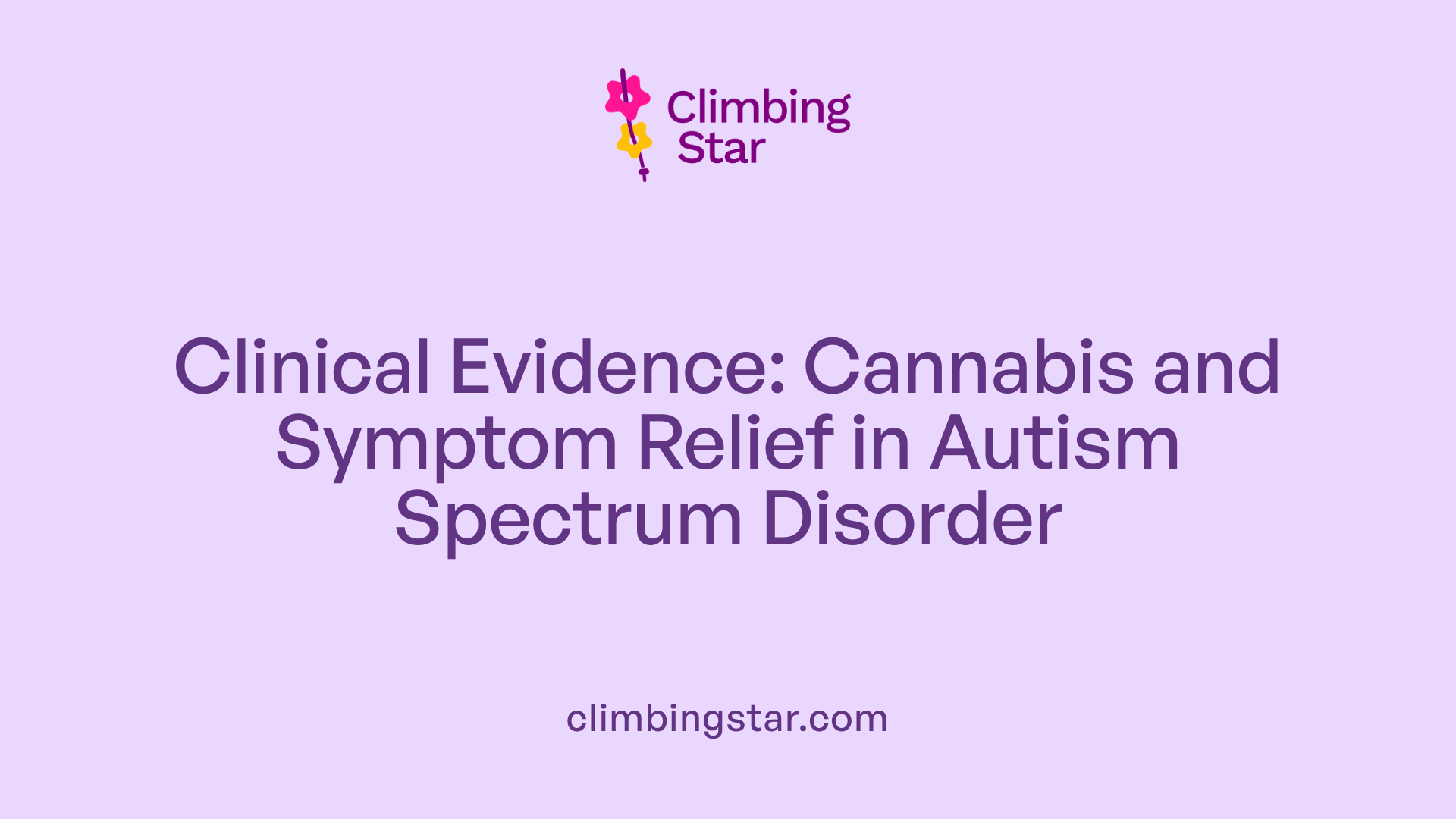
Behavioral symptom relief (aggression, irritability, restlessness)
Cannabis, particularly formulations rich in cannabidiol (CBD), has shown promising effects in reducing behavioral problems associated with ASD. Studies report notable improvements in aggression, irritability, rage attacks, restlessness, and self-injurious behavior. For example, a prospective study involving 188 patients treated mainly with a CBD-rich cannabis oil (30% CBD and 1.5% THC) observed that after six months, 60% of patients reported significant or moderate symptom improvement. Reduction in maladaptive behaviors such as agitation and rage attacks was also commonly reported.
Cognitive and social improvements
Beyond behavioral relief, cannabis treatments have been linked to improvements in cognitive and social functions among individuals with ASD. Enhancements have been observed in attention, sensory sensitivity, social interaction, and language skills. Imaging studies suggest that CBD may modulate brain connectivity and neurotransmitters like glutamate and GABA, which are crucial for excitation and inhibition balance in the brain and are often dysregulated in ASD. This modulation could underpin observed gains in social communication.
Effects on sleep and anxiety
Sleep disturbances, common in ASD, appear responsive to cannabis treatment, with many patients reporting better sleep quality after CBD-rich cannabis administration. Anxiety symptoms, including general, social, panic, and separation anxieties, also showed reductions in treated autistic children. Improvements in these areas were linked to fewer repetitive and rigid behaviors, highlighting cannabis’s role in alleviating both core and comorbid symptoms.
Reported side effects and safety profile
Cannabis treatments were generally well tolerated, with most side effects being mild and transient. Commonly reported side effects included restlessness, sleep disturbances, decreased appetite, and somnolence. In one study, only 25.2% of patients experienced side effects, the most frequent being restlessness at 6.6%. Rare occurrences like psychosis requiring treatment have been documented but remain infrequent. Overall, CBD-rich formulations exhibited a favorable safety profile in ASD populations.
Need for larger controlled clinical trials
Although preliminary evidence is promising, most current data are derived from open-label, observational studies or small sample sizes. The absence of large randomized controlled trials limits definitive conclusions on efficacy and optimal dosing. Experts emphasize the necessity of well-designed controlled clinical trials to establish cannabis’s therapeutic value, safety, and standardized treatment protocols for ASD. Such research is critical to integrating cannabinoid-based therapies alongside behavioral and family interventions effectively.
| Aspect | Findings | Additional Details |
|---|---|---|
| Behavioral improvements | Reduced aggression, irritability, restlessness, rage attacks | 60% of patients showed moderate to significant improvements |
| Cognitive and social gains | Enhanced attention, sensory sensitivity, social interaction, language | Possibly through modulation of glutamate and GABA systems |
| Sleep and anxiety relief | Improved sleep quality and reductions in various anxiety subtypes | Correlated with decreased repetitive behaviors |
| Side effects | Mild and transient (restlessness, sleep disturbances, decreased appetite) | Side effects in approx. 25% of patients |
| Research gaps | Lack of large-scale randomized controlled trials | Needed for definitive efficacy and safety confirmations |
Insights from a Prospective Study of Medical Cannabis in Autism

Study design and patient demographics
Between 2015 and 2017, a prospective study analyzed data from 188 patients diagnosed with autism spectrum disorder (ASD) who received medical cannabis treatment. The participants reflected a varied demographic of autistic individuals experiencing common symptoms such as restlessness (90.4%), rage attacks (79.8%), and agitation (78.7%). This large cohort helped provide valuable insights into the real-world applications of cannabis in managing ASD symptoms.
CBD-rich cannabis oil treatment regimen
Most treatments involved the use of cannabis oil with a composition of 30% cannabidiol (CBD) and 1.5% tetrahydrocannabinol (THC). Patients were typically administered the oil three times daily. Dosages varied to accommodate individual needs, with a focus on CBD-rich formulations to maximize therapeutic effects while minimizing psychoactive impacts associated with THC.
Treatment adherence and duration
After six months of therapy, 82.4% of the initial 188 patients remained in active treatment, indicating good adherence to the cannabis regimen. This sustained engagement suggests tolerability and possible satisfaction with symptom management among the majority of participants.
Symptom improvement percentages
By the six-month mark, 60% of assessed patients reported significant or moderate improvements in their symptoms. Reported benefits included reductions in behavioral challenges such as aggression, irritability, and sleep disturbances. Patients and families also noted enhanced mood, daily activity involvement, better sleep quality, and improved concentration.
Common side effects observed
Cannabis treatments were generally well tolerated, with only 25.2% of patients experiencing side effects. The most frequently reported adverse effect was restlessness, affecting 6.6% of patients. Other side effects included mild and transient issues such as sleep disturbances and appetite changes. Importantly, severe side effects were rare, supporting the relative safety profile of CBD-rich cannabis in this context.
Impact of Cannabis Treatment on Family Dynamics and Parental Stress
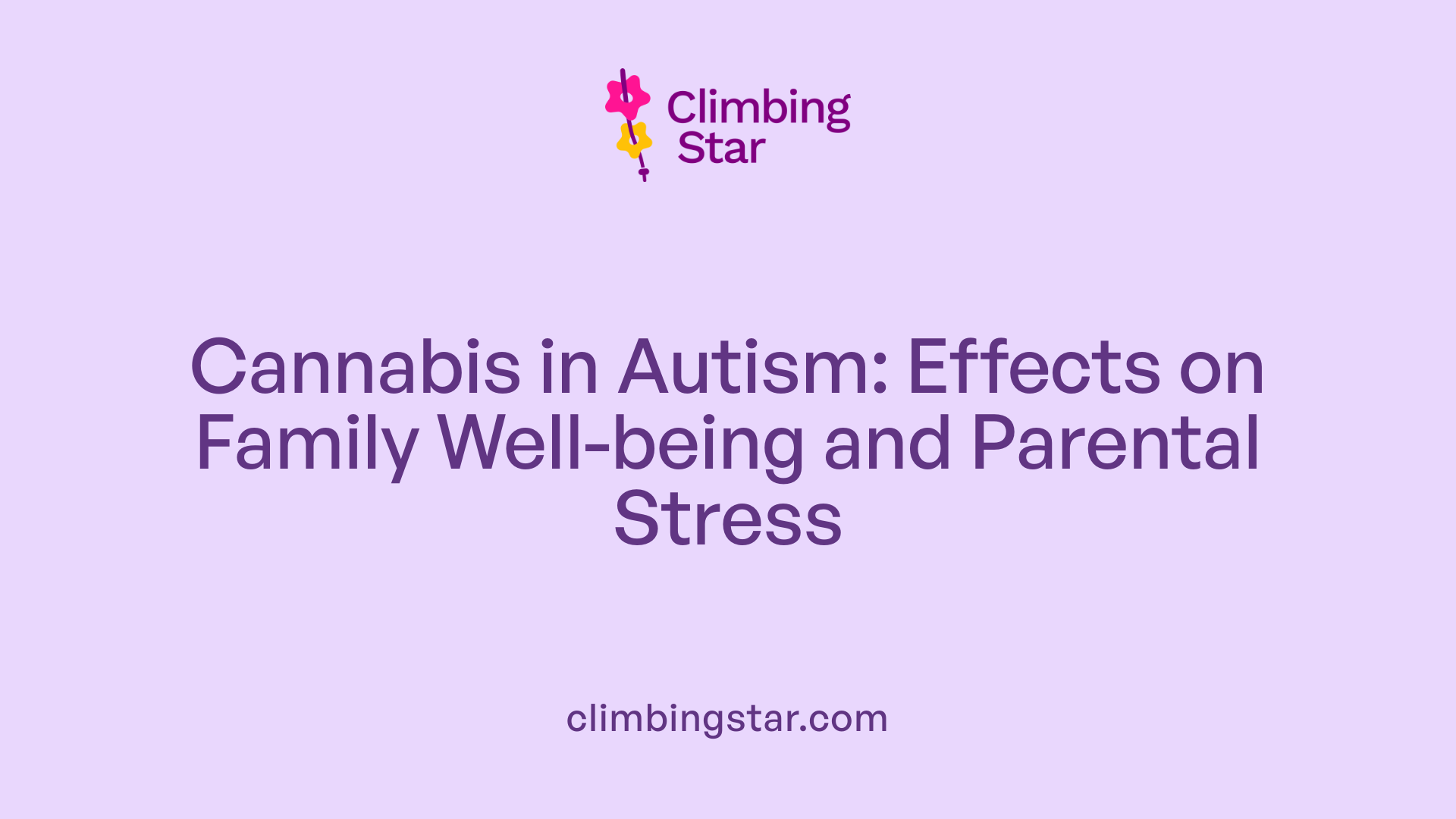
How Does Cannabis Treatment Affect Family Accommodation (FA) in Autism?
Family accommodation (FA) involves the ways family members modify their behaviors or routines to reduce stress or manage the symptoms of a loved one with autism spectrum disorder (ASD). Studies show that CBD-rich cannabis treatment can significantly reduce the frequency of FA. Over a 6-month period, quantitative data from 44 parents revealed marked decreases in these accommodating behaviors — suggesting families feel less compelled to alter routines drastically.
What Is the Effect on Parental Distress?
Parental distress, often heightened due to the challenges of managing ASD symptoms, was notably lowered following cannabis treatment. Parents reported less stress related to caregiving duties, with measurements indicating a consistent reduction in distress scores at both 3 and 6 months after starting CBD-rich cannabis therapy. This suggests a potential easing of caregiver burden aligned with symptom improvements in their children.
How Are Family Routines Improved Through Cannabis Treatment?
Improvements in family routines emerged as a key benefit reported by parents using cannabis treatments for their children with ASD. Enhanced sleep patterns, fewer behavioral disruptions, and better mood regulation in children contributed to more stable and predictable daily family schedules. Such improvements allowed families to regain structure and a sense of normalcy.
What Are the Effects on Parental Well-Being and Social Engagement?
Beyond decreased stress, parental well-being increased post-treatment. Parents described feeling more relaxed and better able to engage in meaningful activities. Social interaction within the family and the broader community improved, reflecting increased participation and reduced social isolation.
What Evidence Supports These Observations?
This insight is drawn from a mixed-methods study combining quantitative analysis of 44 parents with complete data at baseline, 3 months, and 6 months, alongside qualitative interviews with 15 parents. The treatment involved individualized doses of CBD and THC in a 20:1 ratio, averaging 2.87 mg/kg CBD. Improvements were noticeable across measurements, with no significant differences between 3 and 6 months, indicating sustained benefits.
Collectively, these findings highlight that CBD-rich cannabis treatment may serve as a valuable adjunct to behavioral and family interventions in autism, targeting not only the child's symptoms but also reducing family stress and enhancing quality of life.
Cannabis Effects on Anxiety and Repetitive Behaviors in ASD
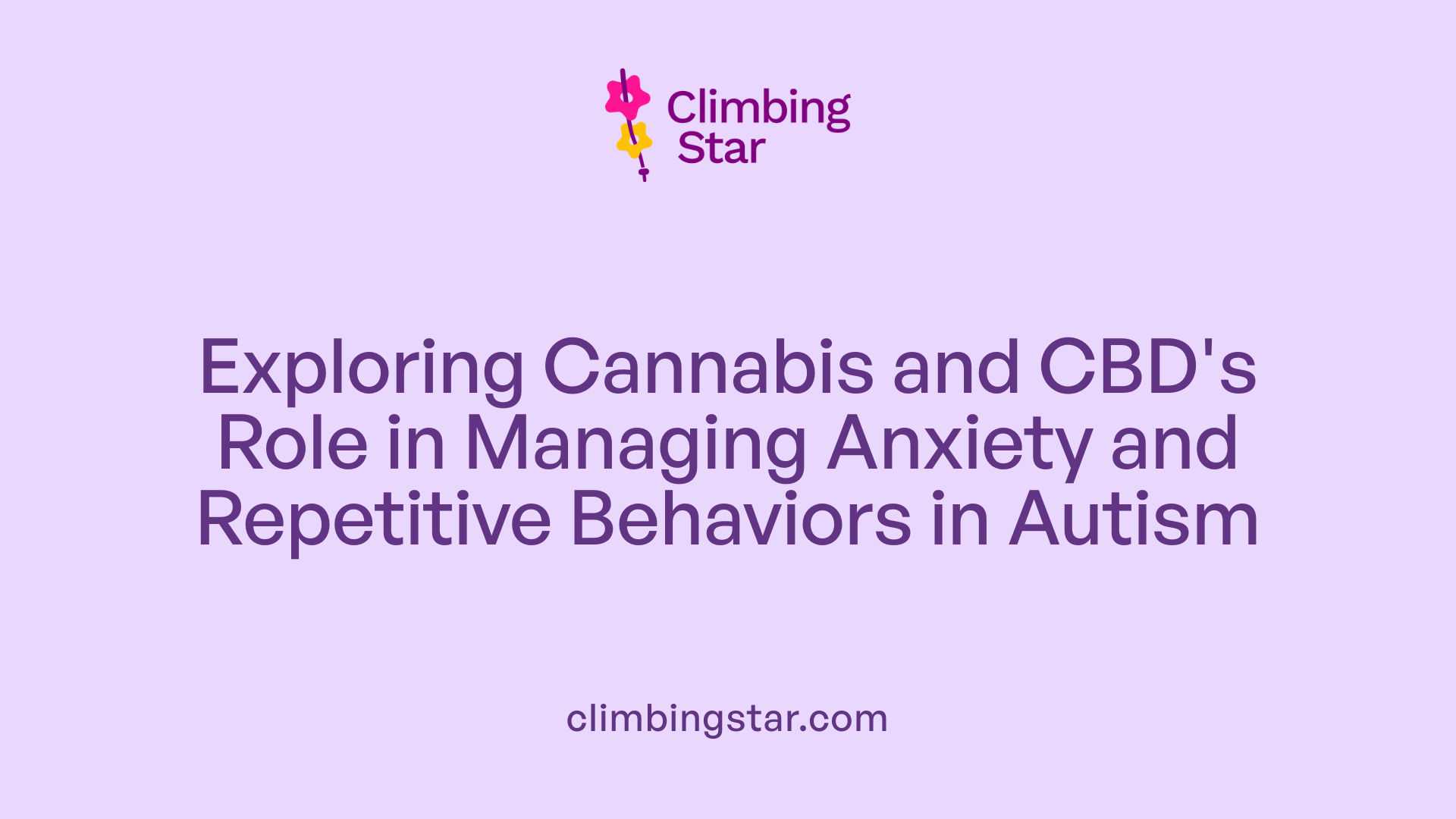
Anxiety Subtypes Affected by Cannabis
Cannabis treatment, particularly with CBD-rich formulations, has been associated with notable reductions in different types of anxiety symptoms in autistic children. These include general anxiety, social anxiety, panic attacks, and separation anxiety. Among these, panic and separation anxieties showed the most pronounced improvement during treatment.
Reduction in Repetitive Behavior Scale–Revised Scores
Alongside improvements in anxiety, cannabis use correlated with significant reductions in scores on the Repetitive Behavior Scale–Revised (RBS-R). This scale measures the frequency and severity of restricted, repetitive behaviors and interests (RRBI), which are core features of ASD. Specifically, cannabis appeared to alleviate compulsive actions, ritualistic behaviors, and insistence on sameness, leading to less severe repetitive behaviors.
Connection Between Anxiety Reduction and Behavioral Improvements
Research findings suggest a close link between the decrease in certain anxiety subtypes and improvements in repetitive behaviors. Reductions in panic and separation anxieties were predictive of decreases in compulsive, ritualistic, and sameness-related behaviors. This relationship highlights how managing anxiety symptoms could directly influence and improve repetitive behaviors in autistic individuals.
Therapeutic Potential for Noncore ASD Symptoms
Beyond core ASD symptoms, cannabis has shown promise in relieving noncore behavioral challenges such as restlessness, rage attacks, agitation, and irritability. Improvements extend to comorbid conditions often seen in ASD, including epilepsy, sleep disturbances, and ADHD-related hyperactivity. By addressing these broader symptom domains, cannabis treatment may reduce dependence on other medications and enhance overall quality of life.
While these findings underscore potential therapeutic benefits, it is important to note that current evidence stems from preliminary and open-label studies. Rigorous, controlled trials are necessary to firmly establish cannabis's safety and efficacy for managing anxiety and repetitive behaviors in ASD.
Balancing Cannabis Use and Safety Concerns in ASD Treatment
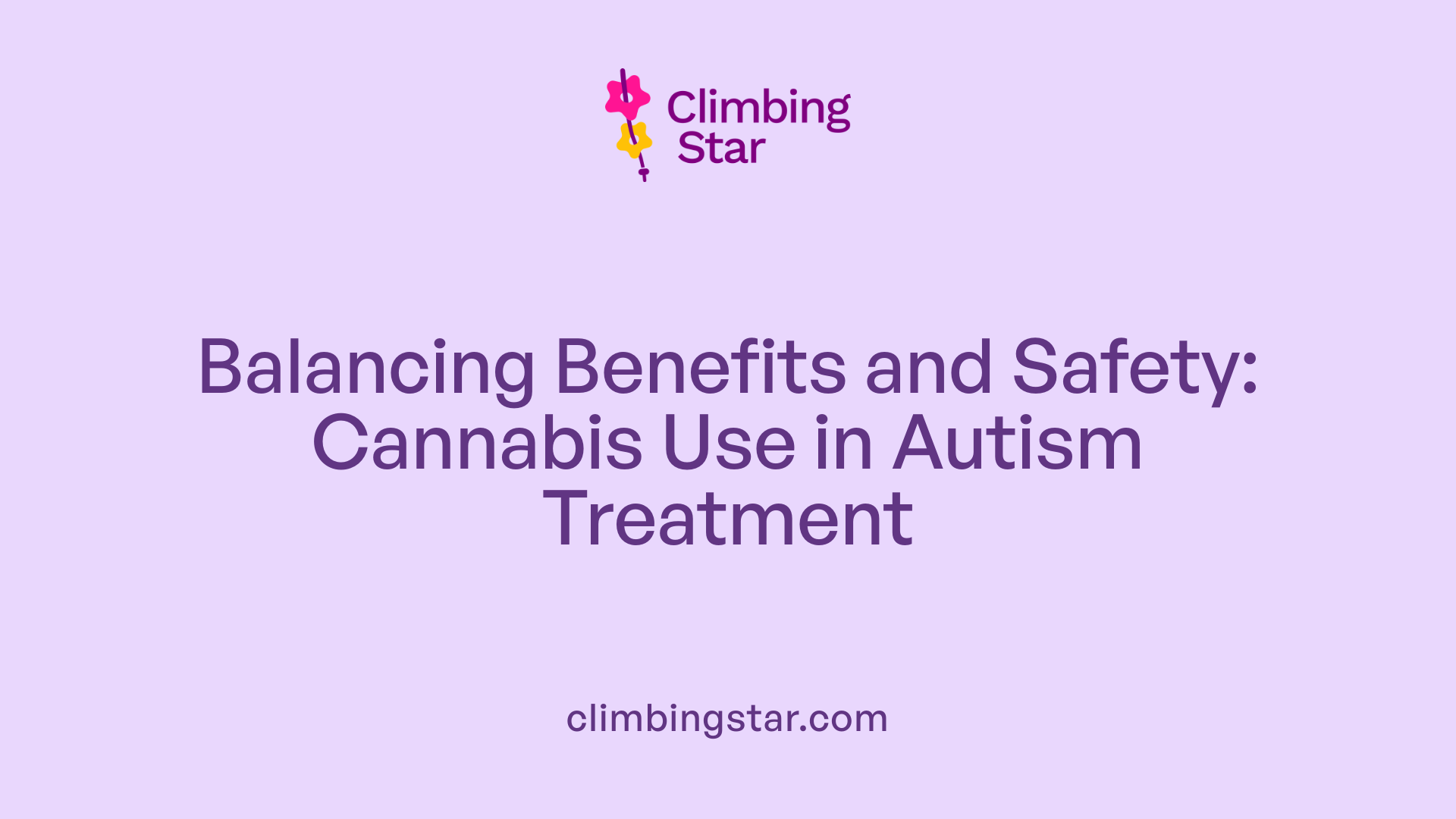
What Common Side Effects Are Documented with Cannabis Use in ASD?
Cannabis treatment in individuals with Autism Spectrum Disorder (ASD) has been generally well tolerated. The most frequently reported side effects include mild and transitory issues such as sleep disturbances, restlessness, somnolence, and changes in appetite. About 25.2% of patients in one prospective study experienced side effects, with restlessness being the most common at 6.6%. These effects often resolve without discontinuing treatment.
Are There Any Rare Severe Adverse Events?
Severe adverse events are uncommon but have occurred. Notably, there has been a single reported case of psychosis requiring medical intervention. Such serious events are rare but highlight the importance of medical supervision during cannabis use in ASD treatment.
How Does Cannabis Side Effect Profile Compare to Other Medications Used for ASD?
Traditional pharmacological treatments for ASD symptoms, such as antipsychotics and stimulants, often carry risks of significant side effects including weight gain, metabolic disturbances, and cardiovascular effects. In contrast, cannabis, especially CBD-rich formulations, tends to have a more favorable safety profile with mostly mild and reversible side effects. Moreover, cannabis may concurrently alleviate multiple symptoms and comorbidities, potentially reducing polypharmacy and exposure to medications with more severe adverse profiles.
What About General Tolerability and Risk-to-Benefit Considerations?
The current evidence suggests that cannabis offers promising benefits in mitigating behavioral and core symptoms of ASD with a generally mild side effect burden. Treatment has been associated with improvements in quality of life, mood, sleep, and social participation. However, given the limited number of controlled trials and the preliminary nature of findings, careful patient selection and monitoring are essential. The risk-to-benefit ratio appears favorable for many, particularly with CBD-rich extracts administered at individualized doses. Still, further rigorous research is necessary to fully establish long-term safety and optimize treatment protocols.
Cannabis as an Adjunct to Behavioral and Family Interventions

Synergy between cannabis treatment and ABA therapy
Behavioral interventions like Applied Behavior Analysis (ABA) are foundational in autism care, focusing on improving social, communication, and adaptive skills. Emerging evidence suggests that cannabis, particularly CBD-rich formulations, may complement these approaches by alleviating symptoms such as irritability, restlessness, and anxiety that can otherwise hinder therapy progress. By reducing these barriers, cannabis can potentially enhance a child’s engagement and responsiveness during ABA sessions.
Enhancement of therapy outcomes
CBD-rich cannabis treatment has been associated with improvements in behavior and emotional regulation, which translate into better participation and effectiveness of behavioral therapies. Parents have reported that their children’s maladaptive behaviors decreased, while social participation and family routines improved throughout cannabis treatment. These changes can create a more conducive environment for behavioral interventions to succeed and yield more consistent outcomes.
Support for family-centered autism care
Beyond direct effects on the child, cannabis therapies appear to reduce parental distress and family accommodation — the modifications families make to adapt to their child's behaviors. Such reductions contribute to enhanced family well-being and improved daily routines, promoting a supportive home setting that reinforces behavioral intervention goals. Qualitative reports emphasize greater parental well-being and engagement in meaningful social activities, highlighting the broader psychosocial benefits of integrating cannabis treatment.
Future directions for integrative treatment approaches
While initial findings are promising, cannabis use alongside behavioral therapies remains an exploratory area requiring robust clinical investigation. Future research should focus on defining optimal dosing strategies, timing, and individualized treatment protocols that synergize cannabis with ABA and similar modalities. Long-term studies will be essential to establish safety profiles and clarify which patients benefit most from combined treatments. Such integrative approaches hold the potential to maximize functional gains and quality of life for individuals with autism and their families.
Regulatory and Legal Considerations Surrounding Medical Cannabis for Autism
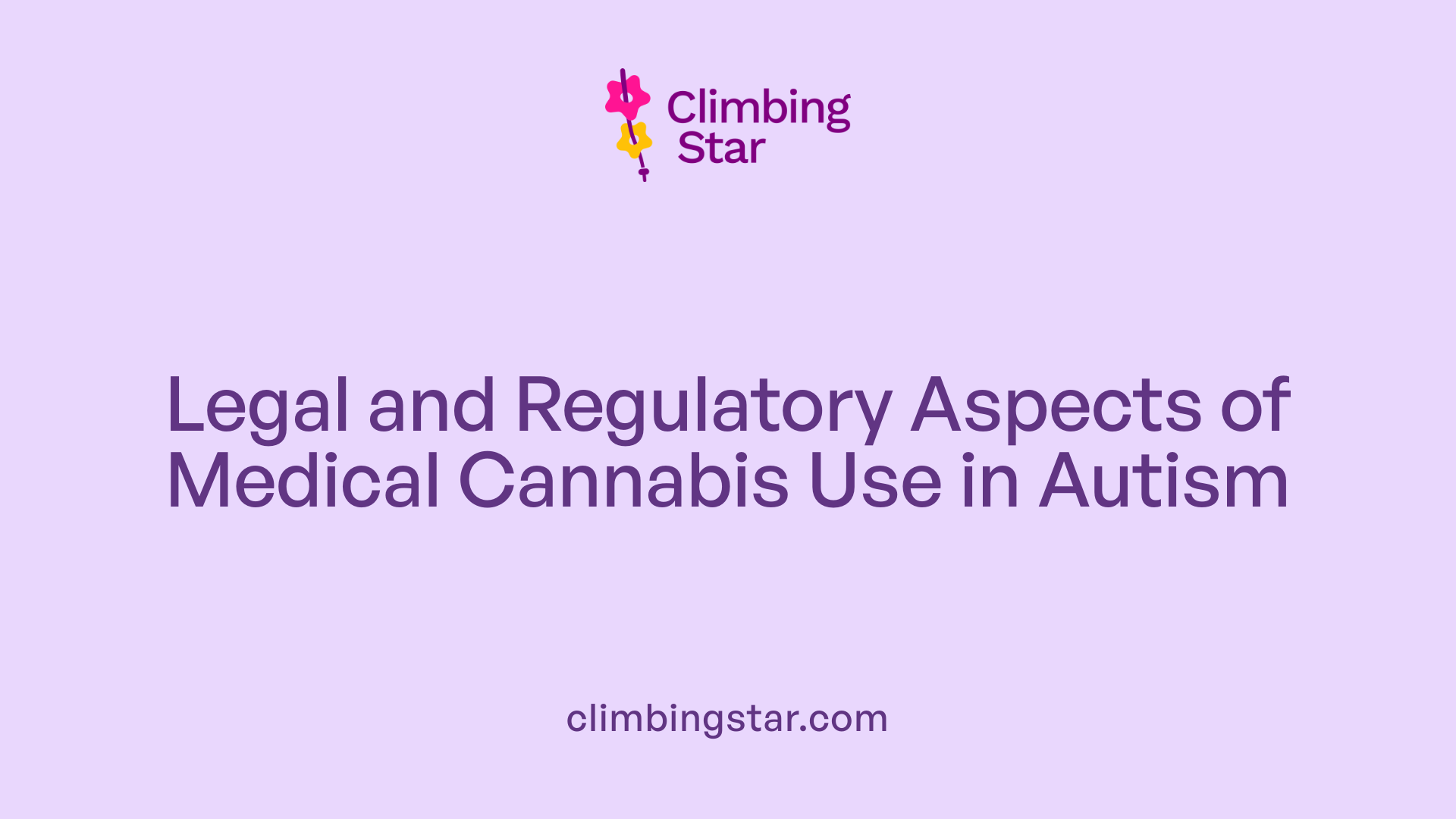
What is the legal status of medical cannabis for ASD across different regions?
The legal landscape surrounding medical cannabis use for Autism Spectrum Disorder (ASD) varies greatly across jurisdictions. In some US states, medical marijuana has been legalized and includes approval for managing symptoms associated with ASD. However, many regions still have restrictive laws that limit or prohibit cannabis use, complicating access for patients and their families.
What challenges do families face in accessing medical cannabis for autism?
Families seeking medical cannabis treatment for autistic children often encounter significant hurdles. These include legal restrictions, scarcity of providers knowledgeable about cannabis therapies, high costs, and lack of insurance coverage. Additionally, inconsistencies in product formulations and dosing create uncertainty and may deter families from pursuing or continuing treatment.
How do these legal factors impact clinical use and research?
The varying legal status affects not only patient access but also the ability to conduct rigorous clinical research. Restrictions can delay or prevent large-scale randomized controlled trials essential for establishing efficacy, safety, and standardized treatment guidelines. This has contributed to reliance on preliminary studies, retrospective analyses, and open-label trials.
Why are standardized protocols essential?
Because medical cannabis products differ widely in cannabinoid content, dose, and administration methods, developing standardized protocols is crucial for ensuring consistent and safe treatment outcomes. Standardization would aid clinicians in prescribing evidence-based therapies, facilitate regulatory approvals, and improve study reproducibility ultimately advancing medical understanding of cannabis for ASD.
The intersection of diverse legal environments and evolving clinical evidence underscores the urgent need for harmonized regulations. Such frameworks would improve access, protect patient safety, and encourage scientifically sound research into cannabis as a therapy for autism-related symptoms.
Future Directions and the Need for Rigorous Research
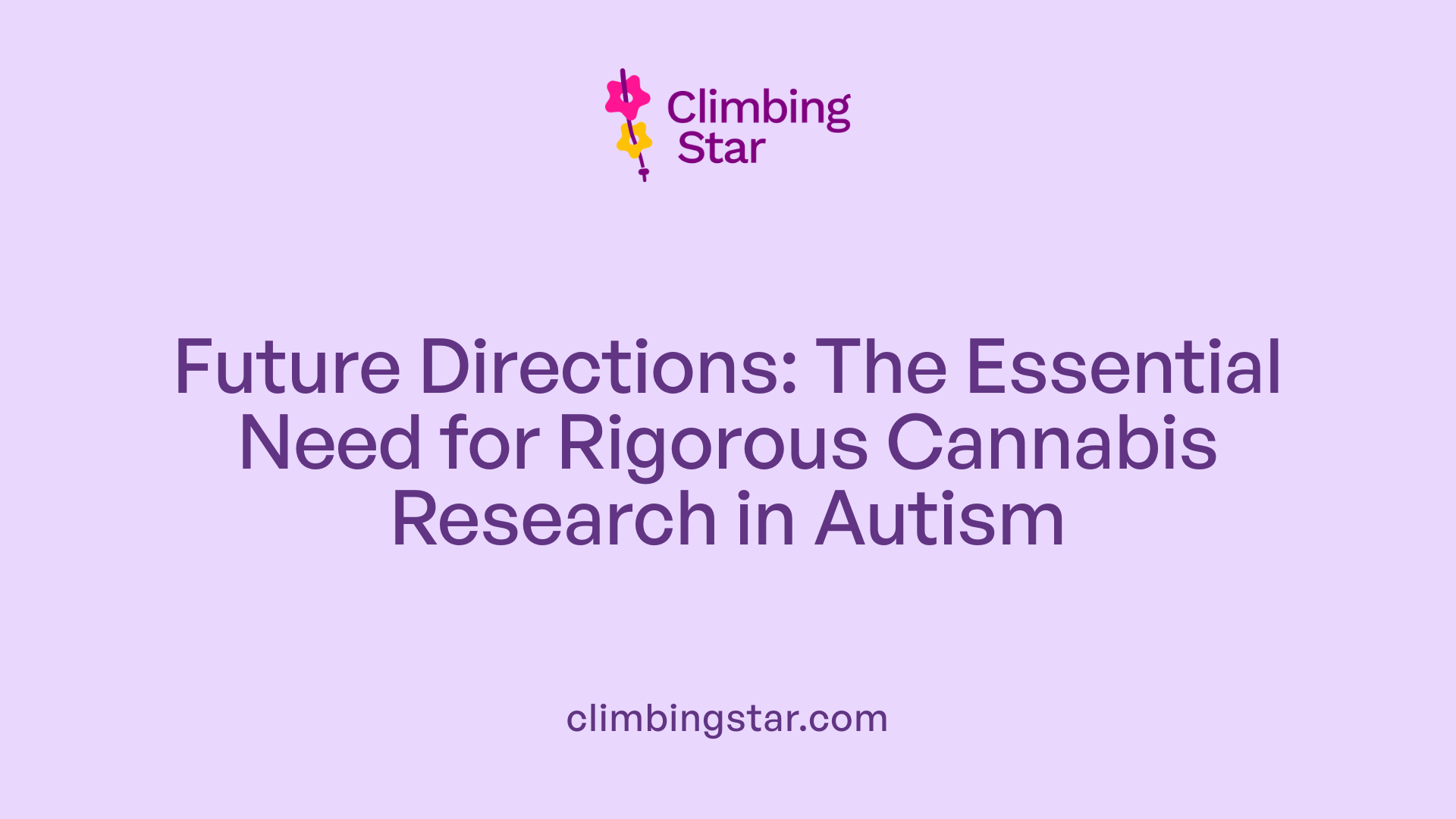
Why Are Randomized Controlled Trials Critical for Cannabis Research in ASD?
Despite promising preliminary findings on the use of cannabis and CBD for alleviating symptoms of autism spectrum disorder (ASD), there remains a pressing need for large-scale randomized controlled trials (RCTs). These studies provide the highest level of scientific evidence, allowing researchers to rigorously assess efficacy and safety, while minimizing bias. Current data largely stem from open-label trials or retrospective analyses, which limit definitive conclusions.
How Should Patient Selection Be Defined for Cannabis-Based Treatments?
Clearly defining which patients might benefit most from cannabinoid therapies is essential. ASD presents with diverse symptoms and severities; thus, identifying specific subgroups based on symptom profiles, comorbidities such as anxiety or epilepsy, or endocannabinoid system biomarkers could tailor treatments more effectively. Personalized approaches may improve therapeutic outcomes and reduce unnecessary exposure.
Why Is Standardizing Dosing and Formulations Important?
Variations in cannabis products used—ranging in CBD to THC ratios and dosages—have created challenges in comparing study results. Standardizing formulations, such as CBD-rich oils with set THC percentages, and establishing dosing guidelines are necessary steps to ensure consistency, reproducibility, and optimal therapeutic dose determination for ASD populations.
What Is Known About Long-Term Safety and Effectiveness?
Most existing studies assess short to mid-term treatment effects, with limited data on prolonged use in children and adults with ASD. Understanding potential long-term side effects, impact on development, and sustained effectiveness is critical before wider clinical adoption. Ongoing longitudinal studies will help clarify these aspects.
How Can Scientific Evidence Gaps Be Bridged?
Addressing gaps involves integrating neurobiological insights—such as cannabinoid interactions with the endocannabinoid system, GABA, and glutamate pathways—with clinical trial data. Collaboration across disciplines and jurisdictions will advance knowledge of mechanisms, therapeutic targets, and patient-centered benefits.
Ongoing research efforts focusing on these future directions will help transition cannabis-based therapies for ASD from experimental to evidence-based clinical practice, improving quality of life for individuals and families affected by autism.
Summary: Integrating Cannabis Insights into Autism Care

What is the therapeutic potential and what are the limitations of cannabis for ASD?
Cannabis, particularly products rich in cannabidiol (CBD), shows promise in alleviating both core and associated symptoms of autism spectrum disorder (ASD). These include reductions in irritability, aggression, anxiety, restlessness, sleep disturbances, and repetitive behaviors. Its mechanism is thought to involve modulation of the endocannabinoid system and neurotransmitter systems like glutamate and GABA, which influence brain excitation-inhibition balance. CBD may also augment endocannabinoid levels by inhibiting enzymatic breakdown.
Nevertheless, current evidence is primarily from open-label and observational studies that report mild and transitory side effects such as sleep issues and restlessness. There is a lack of definitive, large-scale randomized controlled trials, and variability in cannabis formulations and dosing remains a challenge.
What does current evidence say and what questions remain unanswered?
Studies including a prospective trial with 188 ASD patients indicate significant improvements in quality of life, behavior, mood, and social participation after cannabis treatment, with favorable tolerability. Family dynamics and parental distress have also improved in some reports. However, crucial questions remain regarding optimal dosing, the balance of CBD to THC, long-term safety, and whether cannabis can modify core ASD symptoms or mainly addresses associated behavioral issues. Further controlled research is needed to confirm efficacy, better understand mechanisms, and define patient selection criteria.
How does cannabis fit into the broader autism treatment landscape?
Currently, no effective treatments exist for core ASD symptoms. Cannabis and cannabinoids may serve as adjunctive therapies targeting noncore symptoms and comorbidities such as anxiety, epilepsy, and sleep problems. They have potential to reduce reliance on conventional medications but should be integrated cautiously. Medical cannabis use is increasing in some regions under regulations. Given promising but preliminary findings, cannabis therapies may complement behavioral and family interventions to enhance quality of life and reduce parental stress in autism management.
Charting the Path Forward in Autism Treatment
As our understanding of Autism Spectrum Disorder evolves, so too do the therapeutic possibilities. While Applied Behavior Analysis remains a foundational approach, the emerging use of cannabis, especially CBD-rich formulations, presents promising avenues in symptom management and quality of life improvements. Preliminary studies indicate benefits in behavioral, cognitive, and familial domains, with an encouraging safety profile. However, these findings remain nascent and predominantly exploratory. Robust, controlled clinical trials are essential to firmly establish the efficacy, optimal dosing, and long-term safety of cannabinoid therapies within autism care. Integrating cannabis with established behavioral interventions may hold the key to more comprehensive, individualized treatment strategies, ultimately empowering individuals with autism and their families toward better outcomes.
References
- Cannabis and cannabinoid use in autism spectrum disorder
- Real life Experience of Medical Cannabis Treatment in ...
- Effects of Medical Cannabis Treatment for Autistic Children ...
- Cannabis Treatment of Autism in Children: A Literature Review
- Effects of Medical Cannabis Treatment for Autistic Children ...
- Autism Spectrum Disorder and Medical Cannabis
- How to Become an Applied Behavior Analyst (ABA) Therapist
- Applied Behavior Analysis (ABA)
- Applied Behavior Analysis (ABA)
- Applied Behavior Analysis (ABA)







